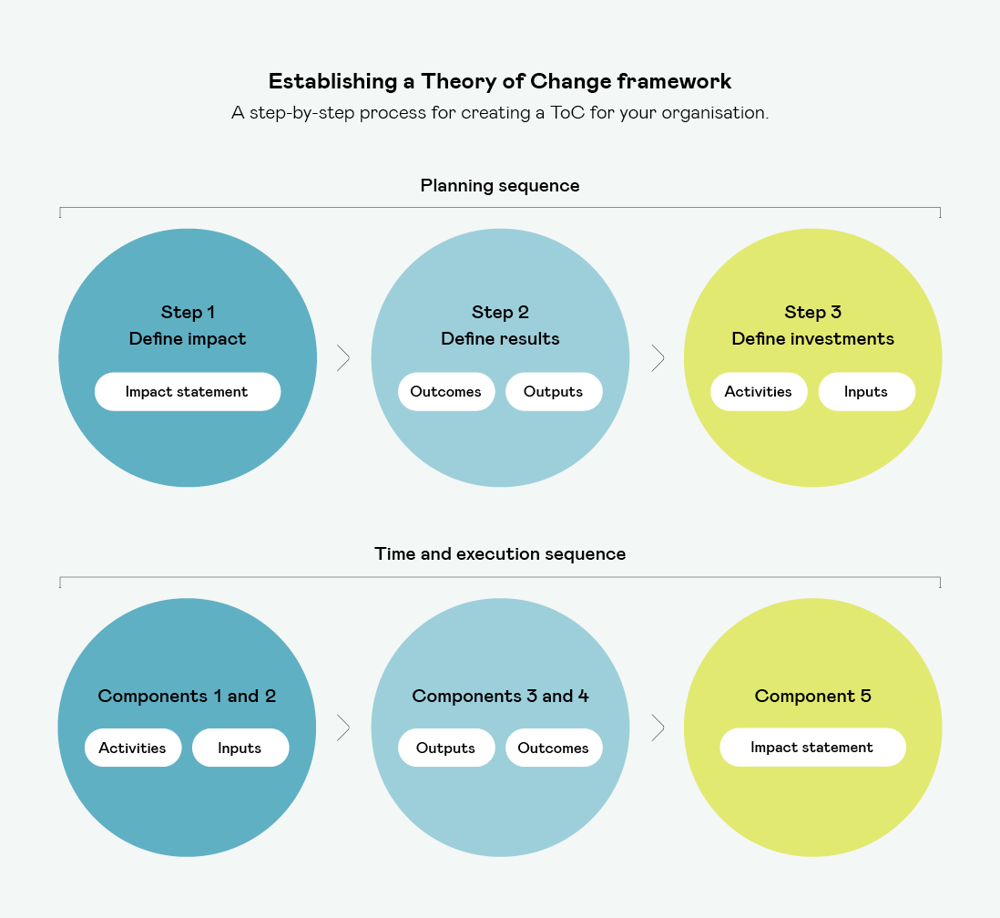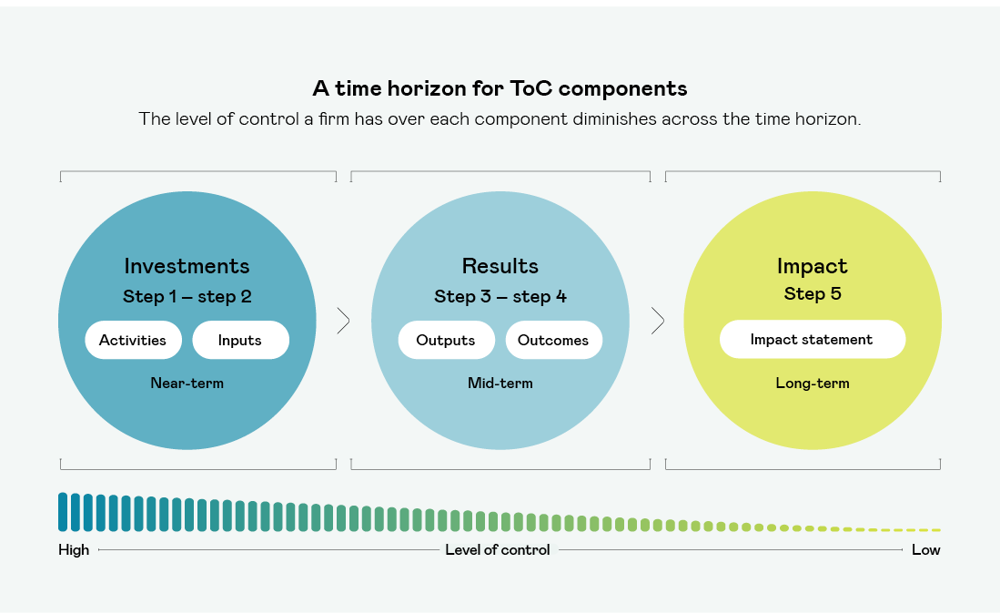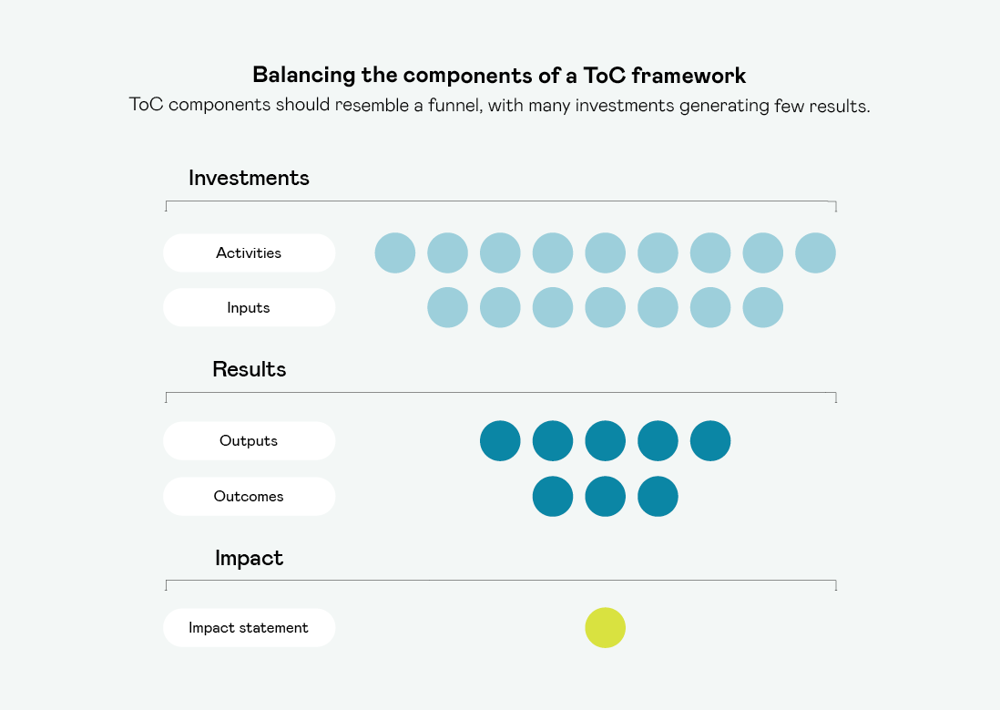Beginning with the end in mind
This guide introduces the concept of a theory of change (ToC) framework, outlining the methodology to follow towards outcome-focused philanthropy

This guide introduces the concept of a theory of change (ToC) framework, outlining the methodology to follow towards outcome-focused philanthropy

Once your corporate giving strategy is fixed and has an established budget, allocated staff time, and your organisation has reached a consensus around the type of impact it would like to have, the most difficult questions lie ahead: how can you tangibly translate these resources into something meaningful? How do you ensure that this time next year you are celebrating success, rather than wondering how to demonstrate what you have to show for the time, money, and effort you have invested?
A Theory of Change (ToC) framework can be a step in the right direction towards achieving this. Simply, a ToC is a theoretical tool used to align up-front investments to end results. To be most useful, the framework must be contextualised by customising the components for a single grant, project, or collection/combination thereof.
Establishing a ToC framework is an initial step towards ensuring that your corporate giving is outcome-focused. This means it is centred upon creating impact instead of responding to impulse. Undertaking a ToC process enables your organisation to have crystal clear clarity around your giving strategy, and specifically:
The benefits of undertaking a ToC process are wide reaching and are summarised below. A ToC:
Historically, ToC frameworks have been used by organisations that interface directly with beneficiaries including non-profits, major donors, and other community or development organisations. Today, ToCs are becoming widely adopted by grantmaking organisations as a mechanism to provide greater insight into giving inputs and outputs.
A Theory of Change (ToC) framework has five key components that can be established through a three-step process. Like many planning tools, a ToC begins ‘with the end in mind’. An organisation works ‘backwards’ across the three steps to establish its very own framework, meaning it first defines what it would like to achieve and then details the efforts and the resources required to meet this goal.

An impact statement is the first component of a ToC framework. It allows an organisation to crystalise the longer-term impact it desires to achieve through its giving. With an impact statement, an organisation essentially defines what success looks like over the long term. They can be drafted for either a single programme or for a collection of related projects or grants.
Your organisation might envision the impact from its giving to be, for example, eradication of hunger amongst the community within ten years of operation. Whatever your impact statement entails, it should at least be clear on what is to be achieved, for whom, and in a timebound manner. Often organisations view this as their social responsibility or sustainability mission, or as a complement to their business vision.
The impact statement characterises the end goal and the remaining components of the ToC are the strategies to arrive there. The first of these are outcomes and outputs, which are effectively the results of the activities and inputs. These are the firm’s investments and are, as such, squarely within their control, while outcomes and outputs are subject to some externalities.
Aside from the impact statement, which outlines longer-term goals, a ToC by design sets a strategy for achieving medium-term results with near-term investments.

The second step in establishing a ToC framework is defining your results. A ToC characterises results with two components: outcomes and outputs. It is easy to confuse impact statements and results, but a simple way to differentiate between them is to consider their time horizon and method of measurement. While both impact statements and results define what an organisation hopes to achieve, impact statements apply to long-term, loftier objectives that tend to rely on proxy indicators to measure success.
Proxy indicators are employed because direct indicators are difficult to identify or collect data against. If your impact statement is to eradicate hunger, you might use statistics around stunted growth or the number of students enrolled in free-lunch programmes to serve as a proxy for levels of hunger, as you would not necessarily have access to a household survey explicitly evidencing daily food insecurity.
Results are comparatively shorter term and more intermediary in nature. They can also be more readily and tangibly measured via more precise indicators.
Outcomes are essentially your medium-term results. You establish your outcomes by defining what you must achieve in two to five years to bring you closer to realising your impact statement. You then assign an indicator by which to measure results. An example of an outcome would be to reduce the number of low-income seniors reliant on community food pantries within three years. A target for the outcome might be to reduce that reliance by 50 percent.
In practical terms, to best define outcomes it is often helpful to think of your mid- term objectives from the prospective of various stakeholders; your board, your beneficiaries, your organisational leadership, your customers may all have different perspectives on what they might like to see achieved through corporate philanthropy.
Success against outcomes is measured first by selecting a set of indicators and then by establishing a baseline. For the example above, your direct indicator to measure your outcome could be the number of seniors registered at food pantries in a 10-mile radius.
The baseline should be measured at the start of a programme or grant, and then data collected to monitor progress at predefined intervals. You can select the intervals that make sense to your collection capacities and the rate at which information changes. Too often, collecting data can be a strain on human resources particularly where IT systems are not in place. Collecting too infrequently can lead to insufficient data to assess results.
Outputs are the third component of a ToC framework. Outputs can be described as short-term results that collectively deliver outcomes. They are the direct result of the investment components, namely the resources committed and activities carried out.
Consider them to be the direct levers to achieve outcomes; if your outcome is to reduce reliance on food banks, then the outputs needed might be financing a cash assistance programmes for seniors. When establishing a set of outputs, it is important to assign a target and actively measure against that target. Carefully monitoring outputs is an efficient way to identify if course corrections are needed.
If output targets are consistently unmet, this should be seen as a welcome warning sign as it allows an organisation to diagnose and correct issues. For example, perhaps your organisation planned a major fundraising event that featured celebrity guests but the money raised (output) fell significantly short of your target. Because you had the signal sent by an unmet target, you can begin to investigate what you invested into the event. You might discover that your promotional budget for the event was too low and hence few people heard about the fundraiser. Alternatively, you may notice that invitations went out too late and many would-be attendees were committed elsewhere.
Outputs can, of course, be swayed by externalities that are completely outside of an organisation's control and even the most carefully planned fundraisers can flop due to something as simple as poor weather, for example.
Perhaps the most straightforward pieces of a ToC are the investment components, which include the activities and inputs. Unlike the results components that can be swayed by externalities and are measured over time, investment components are firmly within your control and can be measured immediately. To detail the investment component, simply focus on the outputs you’ve targeted, and identify the efforts and resources you believe are necessary to achieve them.
Activities refer to any efforts your organisation, or even your grantee, makes on behalf of the results sought. Establishing a grants process, hosting events, devising awareness campaigns, are all examples of activities. Setting targets for your activities is extremely helpful when it come to developing budgets and allocating the final component of a ToC, the inputs.
Inputs are the building blocks of a ToC. These refer to the resources allocated to your activities. If you have targeted three fundraising events, for example, you automatically know that you will require a venue or a budget to lease a space. Or, if you are planning to participate in mentoring sessions at schools, you will need a group of employees to volunteer their time.
It is important to note here that, upon completion, a ToC will look like a funnel, with many investments translating into just a few results. Each outcome may have a handful of related outputs, and those outputs will have a long list of related activities and even longer list of inputs. If you end up having a very similar ratio of inputs to activities, or outputs to outcomes, then you may need to revisit your framework. It is almost impossible for an outcome to be driven by a single output or for an output to be driven by a single input.

A ToC framework is an important tool for driving outcomes-focused philanthropy. However, establishing a framework is only half the exercise. Consistently measuring indicators and targets is as important as establishing them. Only through active monitoring can a framework assist in identifying necessary changes that yield improvements.
Each ToC framework will be unique to the specific needs and requirements of the organisation that designs it. While there are no ‘correct’ answers when it comes to detailing each component, there are some common mistakes that should be avoided.
It's a good idea to use a strong password that you're not using elsewhere.
Remember password? Login here
Our content is free but you need to subscribe to unlock full access to our site.
Already subscribed? Login here